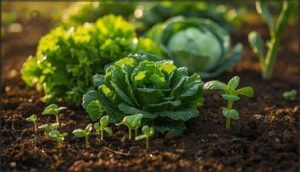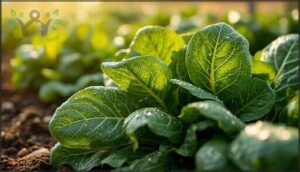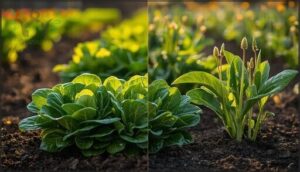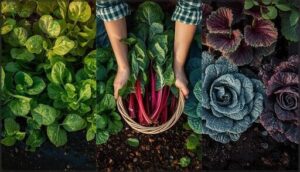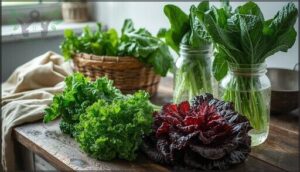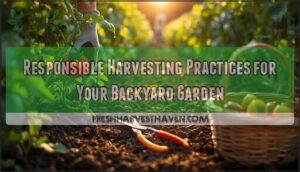This site is supported by our readers. We may earn a commission, at no cost to you, if you purchase through links.
Your leafy greens might lose up to 15% of their vitamin C content in just a few hours if you harvest them at the wrong time. That morning window between 6 AM and 10 AM isn’t just about convenience—it’s when overnight temperatures have locked moisture into leaf cells, creating that satisfying crispness you’re after.
The moment sunlight and heat begin their work, your greens start losing water and nutrients through respiration, transforming yesterday’s tender spinach into today’s wilted disappointment.
Understanding how temperature, plant physiology, and maturity stages align will help you capture that peak freshness window, whether you’re snipping outer leaves for continuous harvests or pulling entire heads at their prime.
Table Of Contents
- Key Takeaways
- Best Time of Day to Harvest Greens
- Identifying The Perfect Harvest Window
- Harvesting Methods for Peak Freshness
- Seasonal Timing for Leafy Green Harvests
- Post-Harvest Handling and Storage Tips
- Frequently Asked Questions (FAQs)
- When to harvest leafy greens?
- When to harvest green leaves?
- What time of day is best for harvesting?
- When should leaves be harvested?
- When is the best time to harvest vegetables?
- When should you pick fresh leafy greens?
- When should I Harvest my Garden?
- How do you harvest leafy greens?
- When can you eat leafy greens?
- Which leaves should you harvest first from leafy greens?
- Conclusion
Key Takeaways
- Harvest your leafy greens between 6 AM and 10 AM when overnight temperatures have locked moisture into leaf cells, delivering up to 15% more vitamin C retention and maximum crispness compared to midday or afternoon picks.
- Use the “cut and come again” technique by snipping outer leaves 1 to 1.5 inches above the base, never removing more than one-third of the plant, which extends your productive harvest window by 4–6 weeks with multiple pickings every 10–14 days.
- Wait at least 24 hours after rain or watering before harvesting to avoid bacterial contamination risks that increase up to 25-fold when picking wet foliage, and always use sharp, clean tools to create precise cuts that minimize bruising and extend shelf life.
- Store your harvested greens at 35–40°F with 90–95% humidity in glass jars with paper towels or specialized containers to maintain peak quality for 10–14 days, keeping them away from ethylene-producing fruits in your coldest refrigerator drawer.
Best Time of Day to Harvest Greens
Timing your harvest can make the difference between crisp, flavorful greens and limp, bitter leaves. Temperature, moisture levels, and the time of day affect how well your plants hold up after picking.
Let’s look at when you should head to the garden for the best results.
Benefits of Morning Harvesting
When your leafy greens wake up with the morning dew, they’re holding their peak hydration and nutrient reserves—that’s the golden window you don’t want to miss. Morning harvesting offers distinct advantages:
Morning harvests capture greens at peak hydration and nutrient reserves—the golden window you don’t want to miss
- Peak Hydration and Turgidity – Cooler overnight temperatures lock in moisture, giving you crisp texture and reducing wilting.
- Nutrient Retention – Greens retain up to 15% more vitamin C before heat stress kicks in.
- Flavor Enhancement – Overnight starch-to-sugar conversion delivers sweeter, more flavorful leaves.
- Extended Shelf-Life and Pest Reduction – Harvesting leafy greens early reduces insect activity and slows degradation, helping your greens last longer in storage.
The best time to harvest leafy greens falls between 6 AM and 10 AM, before temperatures climb above 70°F. This timing helps to guarantee optimal leaf crispness.
Avoiding Harvest After Rain or Watering
While morning harvesting offers clear advantages, timing your harvest around rain and irrigation is equally critical for food safety and quality. Wait at least 24 hours after heavy rain or watering before picking your greens—harvesting wet foliage increases bacterial contamination risks up to 25-fold.
Moisture management isn’t just about crispness; soil splashing can transfer pathogens like E. coli and Listeria onto leaves. Waiting helps reduce the risk of foodborne disease organism development.
Proper harvesting techniques for leafy greens require patience: let soil and foliage dry completely to minimize water quality concerns and soil contamination risks, ensuring both safety and longer shelf life.
Midday and Evening Harvest Considerations
If you can’t pick in the morning, evening harvests outperform midday options. Greens harvested at noon experience up to 18% greater water loss within the first hour, with wilting rates rising 22–30% for spinach and lettuce. Midday heat accelerates nutritional losses—vitamin C drops 15% higher compared to evening picks.
Evening harvesting techniques for leafy greens extend shelf life by up to 17%, reduce microbial growth risks by 13%, and deliver better texture retention during storage.
Identifying The Perfect Harvest Window
Knowing when your leafy greens have reached their prime takes practice, but there are clear indicators that signal the perfect moment to harvest. Each type of green matures at its own pace, and understanding these stages helps you capture peak flavor and nutritional value.
Let’s explore how to recognize when your greens are ready, what signs to look for in popular varieties, and why timing matters before your plants shift into flowering mode.
Maturity Stages of Leafy Greens
Understanding the maturity stages of leafy greens helps you know exactly when your crop is ready. Plant maturity follows a predictable sequence, and recognizing each phase ensures you capture the best flavor profile and tender leaves through precise harvest timing.
- Seedling Development: True leaves emerge 5 to 14 days after germination, marking photosynthetic activity
- Vegetative Growth: Rosette or leaf formation occurs over 25 to 50 days as harvestable mass develops
- Head Formation: Heading types progress from 40% to full size within 45 to 70 days from transplant
- Bolting Indicators: Stem elongation and smaller leaves signal the shift toward flowering
- Maturity Duration: Most greens reach harvest readiness within 40 to 70 days depending on variety
Signs of Ripeness in Common Greens
Bright, vibrant color changes in spinach and kale signal you’ve reached the ideal timing for harvesting greens. Look for leaf size between 4 to 10 inches, firm yet tender leaf texture, and well-defined green veins showing plant health.
Taste a sample—mature leaves turning bitter mean harvesting leafy greens can’t wait. Plant maturity peaks when tender leaves resist wilting but stay pliable.
Harvesting Before Bolting or Flowering
When temperatures climb above 80°F consistently, you’ll want to harvest before flowering to lock in tender texture and mild flavor. Bolting shifts energy from leaves to seeds, triggering bitterness and toughness that no storage trick can fix.
Watch for these bolting prevention signals at harvest time:
- Rapid vertical stem elongation beyond normal growth
- Small flower buds forming at the plant’s center
- Leaves narrowing and becoming more pointed
- Subtle flavor shifts toward bitterness during taste tests
Harvesting leafy greens three to four weeks after seeding maximizes yield while quality preservation remains high.
Harvesting Methods for Peak Freshness
How you harvest your leafy greens matters just as much as when you pick them. The right technique preserves plant health, encourages continued production, and keeps your greens crisp and flavorful from garden to table.
Let’s look at the most effective methods to guarantee you’re getting the freshest harvest possible.
The “Cut and Come Again” Technique
The Cut and Come Again Method is one of the most productive harvesting techniques for cutandcomeagain crops like lettuce, spinach, and arugula.
You’ll harvest early by snipping outer leaves 1 to 1.5 inches above the base, never removing more than one-third of the plant. This cutting location preserves the crown for multiple harvests every 10–14 days, maximizing your yield while supporting steady regrowth timing.
Full Head Harvesting for Lettuce Types
When harvesting head type lettuce like butterhead, romaine, or crisphead, timing determines post-harvest quality and shelf life. You’ll know your lettuce has reached head maturity when it feels firm but not hard—lettuce accumulates 70% of its weight in the final three weeks before best harvest time.
- Variety suitability matters: Butterhead and mini-head varieties form compact heads faster than crisphead types
- Use sharp harvest equipment to cut stems 1 inch below the head base, minimizing damage
- Check your harvest window using compactness as your guide—overly soft heads bruise easily, while excessive firmness signals declining flavor
Selecting Outer Leaves Vs. Whole Plants
Your harvesting strategy affects yield, nutrition, and sustainability. Selective outer leaf harvesting extends productive periods by 4–6 weeks and delivers 12% higher nutritional density scores compared to whole plant removal. The cut and come again method promotes 2–4 harvest rounds, reduces water usage by 25%, and generates 40% less replanting need—maximizing both garden efficiency and vegetable maturity timing.
| Harvest Method | Yield & Regrowth Potential | Nutritional & Environmental Benefits |
|---|---|---|
| Outer Leaves | Allows 2–4 pickings per season; extends harvest window 4–6 weeks | 12% higher nutrient density; 33% less soil disturbance |
| Whole Plant | Single harvest; plant doesn’t regrow after removal | Standard nutrition; requires more frequent replanting |
| Market Considerations | 23% higher consumer satisfaction with outer leaf bunches | Better shelf life (7 days vs. 4 days) |
Using Sharp Tools and Gentle Handling
Think of your harvesting tools as surgical instruments—precision matters. Sharp tools like garden shears, harvesting knives, or sharp scissors create clean cuts that heal faster and minimize bruising, extending shelf-life by up to two weeks.
Dull blades crush stems, inviting disease and reducing quality. Regular tool maintenance paired with gentle handling preserves cellular structure, keeping your greens crisp from garden to table.
Seasonal Timing for Leafy Green Harvests
Your local climate and growing season shape when you’ll get the best harvest from your leafy greens. Most varieties thrive in cooler temperatures, but you can extend your harvest window by understanding which greens suit each season.
Let’s look at how spring, summer, and fall conditions affect your timing and variety choices.
Spring and Early Summer Harvests
As soon as soil temperatures climb to 45-65°F, you can begin planting cool-season greens like spinach, kale, and collards about 2-4 weeks before your last frost date. This timing gives you a harvest window that generally runs from March through early June, depending on your region.
- Bolting prevention: Harvest leafy greens within 3-4 weeks of seeding during warmer spring months
- Planting density: Higher-density plantings require more frequent successive harvests
- Heat-tolerant varieties: Extend your spring harvest window as temperatures rise
- Harvest timing: Pick before bolting occurs for best flavor and tenderness
Fall Harvesting and Frost Tolerance
While spring offers its bounty, fall harvest windows bring a different set of opportunities and challenges. Kale, spinach, and Swiss chard actually thrive in cooler weather, with some tolerant cultivars surviving until the first hard frost.
Light frosts near 32°F won’t harm most fall greens, but temperatures dropping into the high 20s risk significant frost damage. Acclimatization protocols—gradually exposing plants to colder conditions—help minimize tissue injury.
For mitigating frost damage, row covers provide essential frost protection, extending your harvest by up to two weeks.
Choosing Heat-Tolerant Varieties for Summer
When summer heat pushes most lettuce to bolt, choosing heat-tolerant varieties keeps your harvest alive. Batavian Summer Crisp lettuces delay flowering above 85°F, while Malabar spinach and vegetable amaranth use heat-adapted genetics to thrive.
Swiss chard cultivars like ‘Chard Verde da Taglio’ produce continuously in 90°F weather. Orach benefits include sustained yields and tender texture, even when temperatures soar past typical cool-season limits.
Post-Harvest Handling and Storage Tips
Once you’ve harvested your leafy greens at their peak, what happens next makes all the difference between crisp, flavorful leaves and a wilted mess.
Proper handling and storage protect the quality you worked so hard to achieve in the garden.
Let’s walk through the essential steps to keep your greens fresh from harvest to table.
Cleaning and Drying Greens Properly
Washing your freshly harvested greens under cold running water removes soil and microorganisms without harsh chemicals. Here’s how to handle this critical step:
- Use a basin of cool water and agitate leaves gently, changing the water until it runs clear
- Spin dry thoroughly with a salad spinner to control moisture and prevent bacterial growth
- Pat remaining water with clean towels before storage
- Skip soap or bleach, which leave harmful residues
Optimal Storage Containers and Temperatures
After you’ve cleaned and dried your greens, proper storage becomes paramount. The ideal refrigeration temperature sits between 35°F and 40°F, where most leafy varieties maintain peak quality for 10–14 days. Your choice of container dramatically affects shelf life—glass jars with paper towels can preserve greens for 2–3 weeks, while airtight containers reduce moisture loss.
Humidity levels around 90–95% prevent wilting, while airflow control balances moisture retention with gas exchange. Material impact matters—glass inhibits moisture loss better than plastic, though specialized produce containers regulate both humidity and airflow effectively. Position greens in your coldest drawer, away from ethylene-producing fruits, to optimize postharvest storage success.
| Storage Method | Temperature Consistency | Shelf Life Extension |
|---|---|---|
| Glass jars with paper towels | 35–40°F maintained | 2–3 weeks |
| Airtight containers (zip-top bags) | 35–40°F maintained | 10–14 days |
| Perforated plastic bags | 35–40°F maintained | 7–10 days |
| Specialized produce containers | 35–40°F maintained | 10+ days |
| Aluminum foil wrapping | 35–40°F maintained | 4+ weeks |
Preventing Wilting and Extending Shelf Life
Maintaining leafy green freshness after harvesting depends on controlling moisture and environment. Proper drying removes surface water, which accelerates spoilage by 30–50%, while humidity control near 95% in your crisper drawer slows wilting by days.
Harvest handling matters—morning picks retain 15% more moisture, and gentle techniques reduce decay by 25%.
These storage methods work together, preventing leafy greens from wilting while maximizing shelf life through microbial prevention.
Reviving Wilted Greens With Cold Water Soaks
When wilting strikes your harvested greens, cold water soaks can restore crispness through cellular rehydration. Submerge leaves fully in ice-cold water—temperatures below 50°F accelerate revival—for 15 to 60 minutes, depending on severity.
| Leafy Types | Soak Duration | Water Temperature |
|---|---|---|
| Lettuce, arugula | 15–20 minutes | Below 50°F with ice |
| Kale, chard, collards | 30–60 minutes | Ice water bath |
This revival practice maintains nutritional impact while extending storage freshness, without compromising flavor or texture in most greens.
Frequently Asked Questions (FAQs)
When to harvest leafy greens?
The best time to harvest leafy greens seems obvious until you realize younger doesn’t always mean better.
Harvest timing directly affects flavor, nutritional impact, and shelf life—understanding when to harvest means balancing taste vs. maturity perfectly.
When to harvest green leaves?
Understanding when to harvest leafy greens depends on leaf size, color, and texture. Taste testing helps identify best yield during the harvest window. Harvest early when leaves reach full size but remain vibrant green and crisp.
What time of day is best for harvesting?
Like the early bird that catches the worm, you’ll find your greens at their crispest in the morning after dew dries. Cool temperatures boost moisture retention, and sugar accumulation peaks from overnight plant respiration.
When should leaves be harvested?
Your greens are ready when leaves reach best size—2–3 inches for baby varieties, palm-sized for kale. Harvesting leafy greens at this stage ensures peak freshness, taste, and nutritional content before flowering begins.
When is the best time to harvest vegetables?
The absolute worst thing you can do is wait too long—best ripeness dictates flavor development and nutrient density.
Harvest leafy greens between 6:00 AM and 9:00 AM for peak freshness and maximum crispness.
When should you pick fresh leafy greens?
You should pick fresh leafy greens early in the morning after dew dries, when plants are most hydrated and crisp. This ensures the best harvest time for flavor impact, nutritional content, and extended shelf-life.
When should I Harvest my Garden?
Timing is everything when your garden hits its stride. Most leafy greens reach their best harvest windows three to four weeks after seeding, with leaves measuring six to ten inches, showing vibrant color and firmness before bolting begins.
How do you harvest leafy greens?
Use clean, sharp scissors or shears to cut outer leaves 1–2 inches above the base, preserving the growing point for regrowth.
Handle gently to prevent bruising, and harvest every 5–10 days for continuous yields.
When can you eat leafy greens?
You can eat leafy greens at any edible growth stage, from tender baby leaves to full maturity, whether raw or cooked.
Their nutritional value, vitamins, minerals, freshness, taste, and flavor development vary with best leaf size and safe consumption timing.
Which leaves should you harvest first from leafy greens?
Like choosing the ripest fruit from a tree, harvesting leafy greens means picking outer leaves first—they’re oldest and largest, letting younger inner leaves mature while you enjoy continual harvests through selective harvesting.
Conclusion
The early bird catches the worm—and the crispest greens. When you align your harvest with cool morning temperatures and proper maturity stages, you’re working with plant physiology rather than against it.
The best time to harvest leafy greens isn’t arbitrary; it’s when cellular turgor pressure peaks and nutrient content remains highest.
Master these timing principles, handle your greens gently, and store them correctly. You’ll taste the difference that proper harvest timing makes in every bite.
- https://www.sciencedirect.com/science/article/abs/pii/S0304423802000560
- https://www.frontiersin.org/journals/sustainable-food-systems/articles/10.3389/fsufs.2022.811995/full
- https://www.maxapress.com/article/doi/10.48130/tihort-0023-0031
- https://journals.ashs.org/downloadpdf/view/journals/jashs/115/1/article-p182.pdf
- https://repository.si.edu/bitstreams/2b1bd48b-a2f7-4692-874c-5bec81223f9c/download


